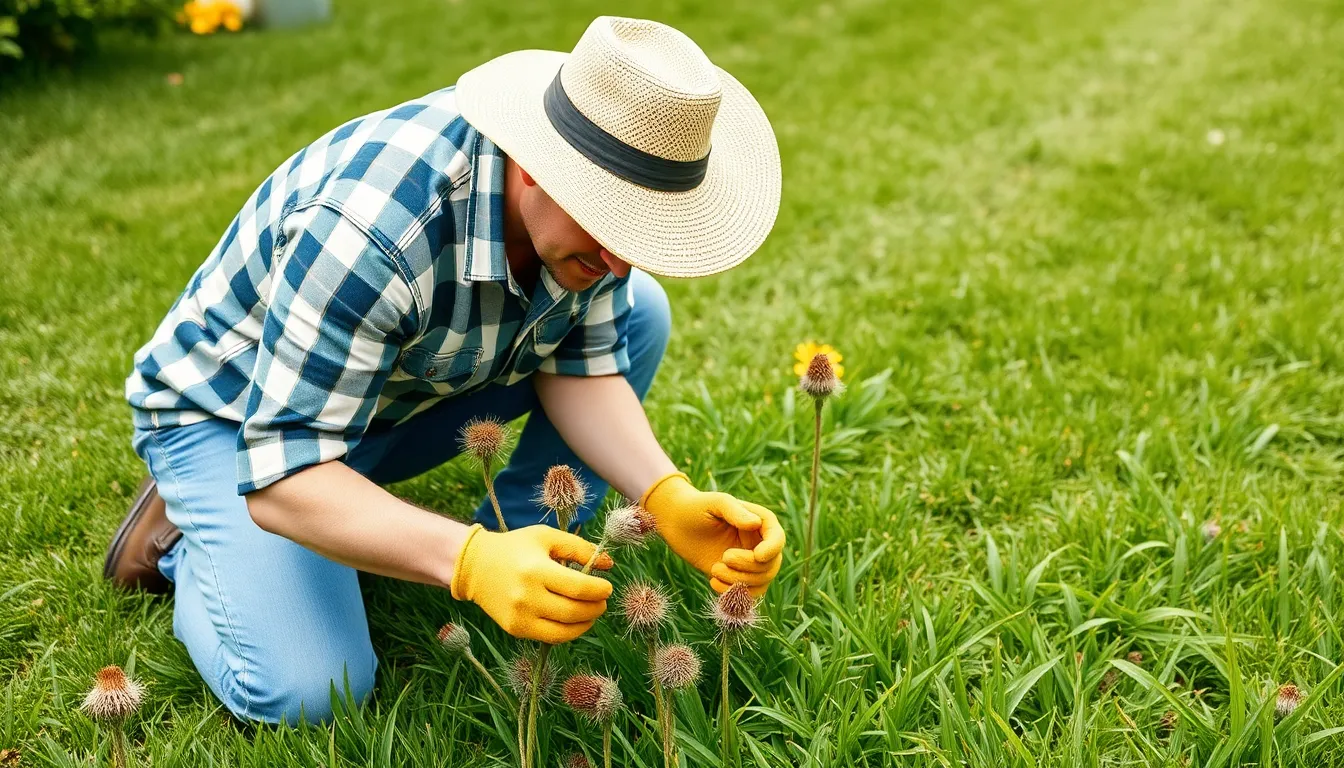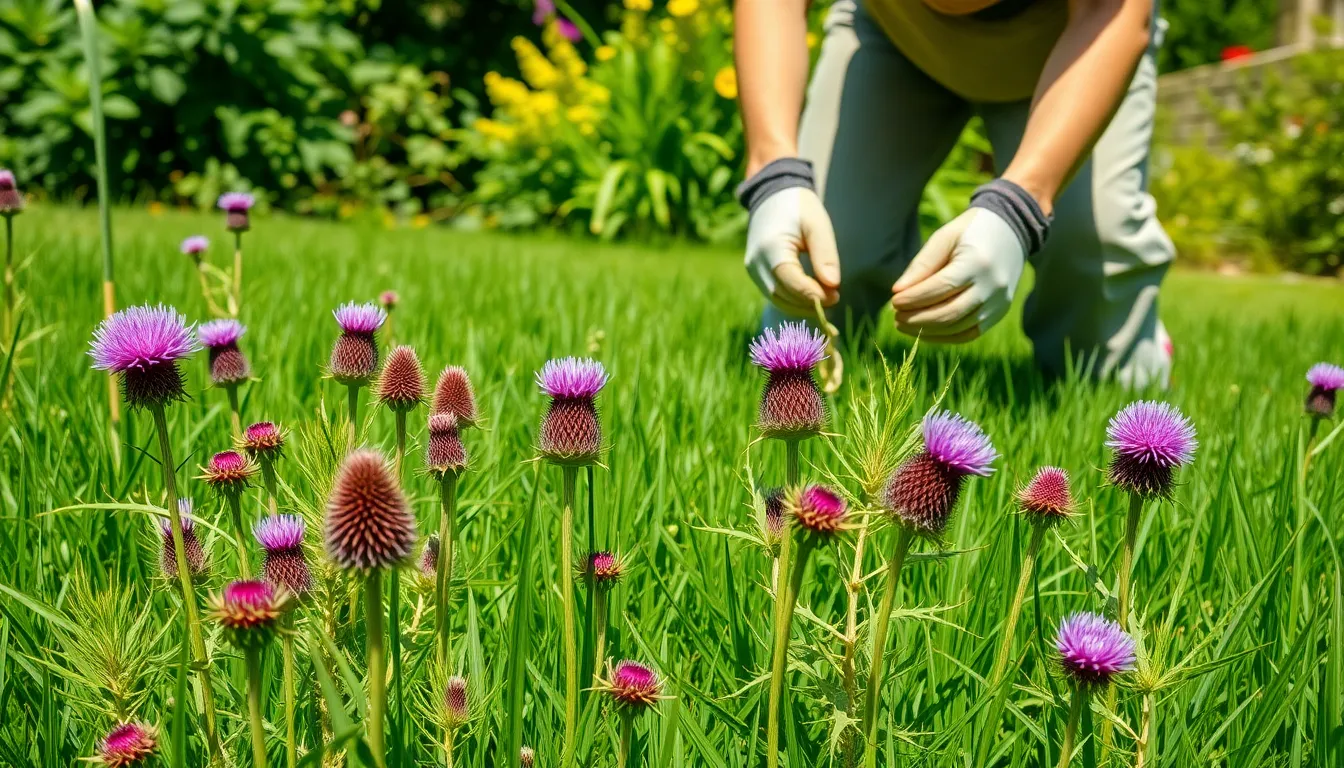Thistles can be the uninvited guests at your garden party, showing up unannounced and taking over the spotlight. While they strut their prickly stuff, your beloved grass is left feeling overshadowed and neglected. The quest to find a solution that zaps those pesky thistles without harming the lush green carpet beneath them can feel like searching for a needle in a haystack.
Table of Contents
ToggleOverview of Thistles and Grass
Thistles pose significant challenges in managing lawns and gardens. Understanding their characteristics and how they differ from grass helps find effective control methods.
The Impact of Thistles
Thistles thrive and compete aggressively with desirable plants. Their extensive root systems enable them to absorb nutrients and moisture, depriving surrounding grass. Many thistle species produce numerous seeds, leading to rapid spread and infestation. As they grow tall and spiny, thistles overshadow grass, negatively impacting its health and aesthetic appeal. Therefore, managing thistles promptly before they establish can help maintain healthier lawns.
Benefits of Grass
Grass provides numerous ecological advantages within landscapes. It stabilizes soil, preventing erosion through its root network. Grass also absorbs carbon dioxide, contributing to cleaner air quality. Additionally, lawns offer recreational spaces for families and pets, enhancing outdoor experiences. They reduce heat by absorbing sunlight, which moderates local temperatures. Healthy grass contributes to a balanced ecosystem by supporting organisms, such as beneficial insects and soil microorganisms.
Common Methods for Controlling Thistles

Effective control of thistles requires specific methods that target these invasive plants without harming grass. Various options exist for gardeners struggling with thistles.
Herbicides
Selective herbicides work specifically on thistles, leaving grass unharmed. Ingredients like dicamba and 2,4-D target broadleaf plants while being safe for grassy species. Applying herbicides in the early growth stages increases effectiveness. Following application instructions is crucial for optimal results. Timing also plays a vital role; applying herbicides during flowering reduces seed production.
Organic Solutions
Numerous organic methods offer alternatives to chemical control. Hand-pulling thistles remains effective for small infestations, ensuring complete removal of roots. Boiling water can kill thistles directly, as it damages cellular structures. Vinegar, with its acetic acid, proves effective in spot treatment as well. Mulching with cardboard or wood chips suppresses thistle growth by blocking sunlight. These organic solutions provide environmentally friendly options for managing thistles while preserving grass.
Effective Herbicides for Thistle Control
Controlling thistles effectively involves choosing the right herbicides that specifically target these invasive plants without harming the grass. Both selective and non-selective herbicides serve distinct purposes in thistle management.
Selective Herbicides
Selective herbicides, such as dicamba and 2,4-D, target broadleaf plants like thistles while preserving grassy species. These chemicals disrupt thistle growth when applied at the early growth stages or during flowering. By this timing, herbicides can significantly diminish seed production, effectively reducing future thistle populations. It’s crucial to apply these herbicides according to the manufacturer’s directions to ensure optimal effectiveness and to minimize any potential impact on surrounding grass.
Non-Selective Herbicides
Non-selective herbicides like glyphosate kill all plant types they contact, including thistles and grass. Caution is essential when using these products, as they can harm desirable lawn species. To mitigate damage, applying non-selective herbicides with precision through spot treatments is effective. Utilizing a shielded spray method or wicking applicator helps in targeting only thistles, thereby preserving lawns. Timely application during active thistle growth enhances the effectiveness of these herbicides for total control.
Natural Alternatives to Chemical Treatments
Natural alternatives to chemical treatments can effectively manage thistles while protecting grass. These methods often reduce environmental impact and enhance gardening practices.
Vinegar-Based Solutions
Vinegar serves as a potent natural herbicide, especially when its high acidity targets thistles. A 20% vinegar solution proves more effective than standard household vinegar, which contains about 5% acetic acid. Spraying this concentrated vinegar directly onto thistles during sunny conditions encourages rapid damage and desiccation. When applying, ensure to cover the leaves thoroughly for optimal results. Vinegar spot treatments minimize harm to surrounding grass, making it a favored option for eco-conscious gardeners.
Essential Oil Applications
Essential oils offer another effective method for thistle control. Clove and cinnamon oil stand out for their ability to inhibit weed growth due to their natural herbicidal properties. Mixing these oils with a carrier solution enhances their effectiveness against thistles. Application occurs ideally on warm, dry days, allowing the oils to penetrate the plant’s tissues. Targeting thistles directly ensures minimal impact on grass, creating a safer alternative for lawn management.
Integrated Pest Management Strategies
Integrated pest management (IPM) strategies combine various approaches to control thistles while preserving grass health. Implementing these strategies reduces reliance on chemical herbicides and promotes long-term ecological balance.
Cultural Practices
Cultural practices enhance lawn health and reduce thistle prevalence. Planting grass at higher densities discourages thistle growth by outcompeting them for resources. Maintaining optimal soil moisture through regular watering supports grass vigor, allowed grass to thrive. Additionally, fertilizing the lawn with nitrogen strengthens grass, making it more resilient against thistle invasion. Proper mowing techniques, such as keeping grass at an appropriate height, also promote stronger turf while limiting thistle seed spread.
Mechanical Removal
Mechanical removal effectively manages thistles without chemical intervention. Pulling thistles by hand is most effective when the soil is moist, as this ensures the entire root is removed. Using a hoe or a spade can assist in uprooting thistles, especially for extensive root systems. Regular mowing of thistles before they flower helps prevent seed formation, reducing future infestations. Employing a mulch layer on garden beds further suppresses thistle regrowth by blocking light.
Managing thistles without harming grass is essential for maintaining a healthy lawn. By employing selective herbicides or organic methods like vinegar and essential oils, gardeners can effectively target thistles while preserving their grass. Integrated pest management strategies further enhance lawn health by combining cultural practices with mechanical removal techniques.
Timely intervention is crucial to prevent thistles from spreading and competing for resources. With the right approach, it’s possible to create a thriving ecosystem that supports both grass and beneficial plants, ensuring a beautiful and sustainable garden.







